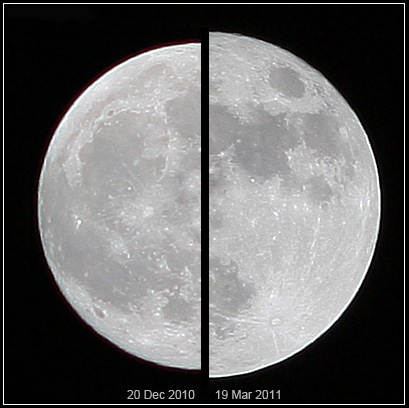A supermoon is a full moon or a new moon that nearly coincides with perigee—the closest that the Moon comes to the Earth in its elliptic orbit—resulting in a slightly larger-than-usual apparent size of the lunar disk as viewed from Earth.
The technical name is a perigee syzygy (of the Earth–Moon–Sun system) or a full (or new) Moon around perigee.
The term supermoon is astrological in origin and has no precise astronomical definition.
The real association of the Moon with both oceanic and crustal tides has led to claims that the supermoon phenomenon may be associated with increased risk of events like earthquakes and volcanic eruptions, but no such link has been found.
The opposite phenomenon, an apogee syzygy or a full (or new) Moon around apogee, has been called a micromoon

Comparison of average moon versus super moon. image: Marcoaliaslama /wikipedia
How often do perigee moons occur?
Of the possible 12 or 13 full (or new) moons each year, usually three or four may be classified as supermoons, as commonly defined.
The most recent full supermoon occurred on January 21, 2019, and the next one will be on February 19, 2019.
The one on November 14, 2016 was the closest full supermoon since January 26, 1948, and will not be surpassed until November 25, 2034.
The closest full supermoon of the 21st century will occur on December 6, 2052
How it appears
A full moon at perigee appears roughly 14% larger in diameter than at apogee. Many observers insist that the moon looks bigger to them. This is likely due to observations shortly after sunset when Moon is near the horizon and the moon illusion is at its most apparent.
While the moon's surface luminance remains the same, because it is closer to the earth the illuminance is about 30% brighter than at its farthest point, or apogee. This is due to the inverse square law of light which changes the amount of light received on earth in inverse proportion to the distance from the moon.
While a typical summer full moon at temperate latitudes provides only about 0.05-0.1 lux, a supermoon directly overhead in the tropics could provide up to 0.36 lux
Source adapted from: Wikipedia contributors. (2019, January 21). Supermoon. In Wikipedia, The Free Encyclopedia. Retrieved 04:01, February 20, 2019, from https://en.wikipedia.org/w/index.php?title=Supermoon&oldid=879449831